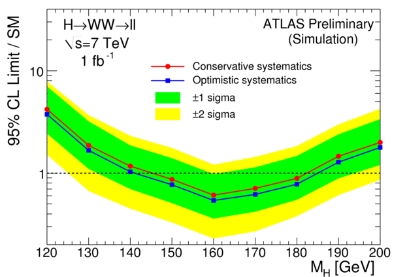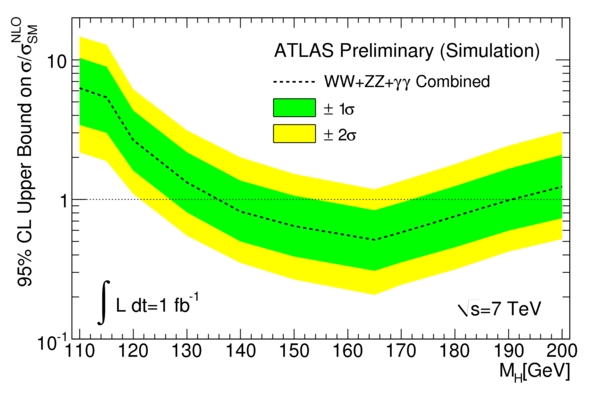The most lucky among us will hear about these projections in the dedicated talks in Paris. I, however, have to lament my absence from the beautiful French capital: being confined in a remote island of the Aegean Sea, I can only peek at the results from a distance. In this particular case with some advance, thanks to the openness of the public ATLAS pages.
Here I will just flash a couple of the results, because the plentiful online documentation that ATLAS provided makes it a worthless exercise on my part to just echo it here. However, maybe I can comment the most relevant plots for those of you too lazy to browse the information-thick ATLAS pages.
Higgs to W boson pairs
By far the most sensitive channel for a search of an intermediate-mass Higgs boson at the LHC is the one involving the production of the Higgs followed by its decay to two W bosons of opposite charge. Backgrounds include the direct production of two W bosons without the intercession of the Higgs, as well as the production of a top-antitop quark pair, which decays into two W bosons and two additional b-quark jets.
The cleanest way to observe W bosons is to detect their decay into electron-neutrino or muon-neutrino pairs. But this unfortunately only happens two times out of nine for each W particle, because there are nine possible ways for the W to disintegrate (others being tau-neutrino pairs, plus three each of up-down and charm-strange quark pairs). All in all, if we want both W bosons to yield electrons or muons, this happens only four times in 81, which reduces significantly the yield of this already elusive process. Elusive is the word: Higgs production occurs less than once in a billion collisions!
To compensate for the loss of the hardly detectable decays of W bosons to quarks or tau leptons, we note that if the Higgs boson has a mass close to 160 GeV -i.e. twice the W boson mass- the decay H->WW is almost certain. It can still occur, at a smaller rate, if the Higgs has a mass below 160 GeV, but then one of the W bosons will be "virtual": it will be in other words unnaturally light, and its decay products will be less energetic. Because of the smaller rate and less energetic final state objects, the sensitivity of the WW channel decreases for masses below 160 GeV.
The sensitivity also decreases if the Higgs is heavier, because the heavier the particle is, the less probable is its production: this is due to the well-known feature of hadron colliders, whereby the quarks and gluons inside the colliding protons are harder to find carrying large fractions of the parent's energy, while more energetic gluon pairs are needed to produce heavier Higgs bosons.
ATLAS studied its discovery reach by first developing a very careful search strategy, and then performing it on simulated data. This allowed them to produce the information summarized in the figure below.

The figure shows the by now customary "brazil band", describing in this case what ATLAS expects to get with one inverse femtobarn of collisions, an amount of data which will be collected by the end of next year. On the horizontal axis you see the unknown value of the Higgs mass, while on the vertical axis there is the production rate of Higgs bosons, in units of the expected standard model rate. The horizontal hatched line reminds us what is the standard model expectation.
Now let us take the red points and try to understand what they mean. At 150 GeV, the red point lies at a value of about 0.8. This means that on average (but I should say "at least 50% of the time", since the points describe the median and not the mean of a distribution of limits) ATLAS expects to exclude, at 95% confidence level, that the Higgs boson has a production rate larger than twice the standard model expectation, if the particle has a mass of 150 GeV.
In other words, give ATLAS that much data, and with the WW search alone they will exclude that the standard model Higgs boson has a mass of 150 GeV. But this is only valid on average: backgrounds may fluctuate, and they may affect the limit that ATLAS can in fact set. This is described by the brazil band: all points within the green band, at the same 150 GeV abscissa, are ones that may occur 68% of the time, and all those within the green plus yellow band may occur 97% of the time. This implies that at 150 GeV the limit might well end up being at twice the standard model rate, or at 0.3 times the standard model rate: 0.8 is just the median of a wide distribution of possible outcomes of the experiment, when run on one single set of 1-femtobarn data.
Having understood what the green and yellow bands mean for a single mass point, we can see what exactly the whole curve means: while the region that on average will be excluded is, if my eyes do not fail me, 145-182 GeV (the region bracketed by the points where the red line cross the hatched horizontal line), ATLAS might be "lucky": with a 1-sigma downward fluctuation of the backgrounds the exclusion might end up being between 133 and 192 GeV (points where the lower limit of the green band meet the hatched line); with a two-sigma downward fluctuation, the limit might be all the way from 125 and over 200 GeV!
Of course, we are making two unnecessary assumptions here. The first one is that there is no Higgs boson! Of course, if the Higgs is present, the limit that will be obtained will be worse than the red line, in some region of the mass distribution. The second assumption is that the data "fluctuate" down coherently for different mass searches: you have to realize that the search details are different for different mass values, so when we say "the data fluctuates down" we are making approximations to a more complex situation.
Finally, the ATLAS note also gives the predicted minimum luminosity necessary to observe a Higgs boson in the WW final state, as a function of Higgs mass. From table 9 in their public document we thus learn that about 4.8 inverse femtobarns of proton-proton collisions will be necessary to achieve a 5-standard-deviation significance, if the Higgs mass is 160 GeV. For other masses, the required amount of data rapidly increases -but of course this is only relevant for the H->WW search alone.
Combined Reach
ATLAS produced 95% limit plots similar to the one shown above for other searches of the standard model Higgs boson; you can find all the material here. The most relevant summary is however in the combined reach plot, which takes three independent searches for the Higgs and produces a combined 95% confidence level limit on the Higgs rate.
Besides the W-pair search described above, the two others included in the combination are the search for Z-pairs, and the search for photon pairs. The former is sensitive mostly at high mass, when the Higgs may decay into two real Z bosons; the latter provides sensitivity in the low-mass region, where the decay of the Higgs into just two light quanta is at its highest rate -albeit still roughly once in a thousand times!
By now, you have all the information needed to decode the graph, so here it is below.

We learn that one inverse femtobarn of collisions will allow ATLAS to exclude, on average, quite a large chunk of Higgs boson masses! The exclusion will likey be between 135 and 190 GeV, but a "2-sigma lucky" downward fluctuation of backgrounds in the data might allow to exclude from 120 GeV all the way to 200 GeV or more.
Note that ATLAS has not included in the summary a couple of search channels that will provide added sensitivity in the low-mass region: notably, the search for decays to tau-lepton pairs and the one for b-quark pairs. If you add to this the fact that this is only half of the sky -the other half being CMS, the competing experiment at LHC, which is likely to have a similar sensitivity to the Higgs boson- you might well take home an interesting concept: if the Higgs boson does not exist, we might get a significant hint of its being a "fairy field" already toward the end of next year.

No comments:
Post a Comment
Note: Only a member of this blog may post a comment.